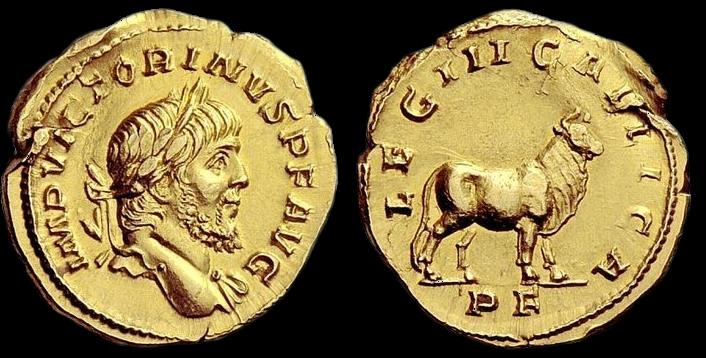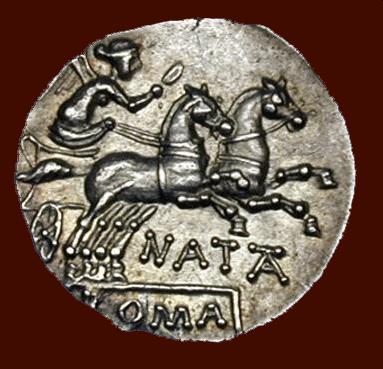




Designed by Nigel G Wilcox


The Paragon Of Metal Detecting
& Archaeology
& Archaeology
Powered By Sispro1
Roman Denarius A.D. - Currency Numismatics,
For Reference ONLY
Everything For The Detectorist
Victorinus 269 271 AD
Roman Timeline
Roman Menu
Copyright All Rights Reserved by Nigel G Wilcox E-Mail: ngwilcox100@gmail.com
| 1. Estimated Value 2022 |
1.
A Unique Roman Gold Aureus of the Romano-Gallic Emperor Victorinus (269-271 C.E.)
Victorinus, 269 – 271
Aureus, Colongne January 271, AV 4.89 g. IMP VICTORINVS P F AVG Laureate bust r., with drapery on l. shoulder. Rev. LEG III GALLICA Bull standing r.; in exergue, P F. C –. RIC 14 (this coin, misdescribed). Schulte 32a (this coin). Elmer 714 (this coin). Calicó 3829 (this coin).
Apparently unique, an issue of great importance and fascination. A magnificent portrait
of superb style, flan crack at ten o’clock on obverse and slightly bent,
otherwise extremely fine
Ex Christie’s 10 October 1984, Property of a Lady, 136 and Leu 52, 1991, Distinguished American collection, 251 sales.
A series of great interest is the legionary aurei of Victorinus, which names at least 14 legions and portrays their badges. Their rarity allows for the list to be supplemented by new finds, as this particular type of Third Gallica may only have been known since the late 19th Century. The legionary badges usually are those traditionally recognised for the legion named, but sometimes they are different, reflecting either a change that is otherwise undocumented or, more likely, misinformation at the mint. It is generally agreed that Victorinus did not have within his own army the legions or attachments of all of the legions named on his aurei. If so, the coinage must be seen not as an act of mere recognition, but partly as an outreach to legions beyond his sphere of government. About three centuries before Marc Antony did likewise with his legionary series by naming the legions under his command and those in Octavian’s camp. The legions named by Victorinus cover the geography of the Roman world, from Caerleon and Chester in Britain, to Syria, Phoenicia, Mesopotamia and Egypt in the East. Mattingly, in his 1936 study of this coinage, notes that the series does not mention the armies in Rhaetia, Noricum and Italy (III Italica, II Italica, II Parthica, the Praetorian Guards and the cavalry corps in Milan). He suggests this was due to their attachment to Quintillus, who ruled briefly in 270 before the uprising of Aurelian, though it might be better associated with the aggressions in Gaul of Claudius II, which caused a protracted siege of Autun. This aureus celebrates the Third Gallica, an old and famous legion that seems originally to have been founded by Pompey the Great in about 65 B.C. He used it to fight the rebel Sertorius in Spain, the slave army of Spartacus, and to pacify Western Spain and Portugal. But it was eventually defeated by Julius Caesar, who honourably disbanded it, only to re-form it in 49/8 B.C., seeking his recruits in Transalpine Gaul, as Pompey had done originally. This legion is known to have been stationed in Bithynia under Marc Antony, who used it for his invasion of Parthia. The details are imprecise, but it seems to have served in Pannonia under Tiberius, in Syria under Claudius, and was along the Danube in 68 to replace the Fifth Macedonia during the Civil War. At that time the legion fought for Vespasian at the Battle of Cremona, after which it was moved to Syria, where it appears to have been based at least through the third Century. Provincial bronzes of Tyre of third Century testify to its legacy in the region, showing a banner inscribed LEG III GAL. Another famous legion of the East, the X Fretensis, which also used as its badge a standing bull, was included in Victorinus’ series.
Victorinus, 269 – 271
Aureus, Colongne January 271, AV 4.89 g. IMP VICTORINVS P F AVG Laureate bust r., with drapery on l. shoulder. Rev. LEG III GALLICA Bull standing r.; in exergue, P F. C –. RIC 14 (this coin, misdescribed). Schulte 32a (this coin). Elmer 714 (this coin). Calicó 3829 (this coin).
Apparently unique, an issue of great importance and fascination. A magnificent portrait
of superb style, flan crack at ten o’clock on obverse and slightly bent,
otherwise extremely fine
Ex Christie’s 10 October 1984, Property of a Lady, 136 and Leu 52, 1991, Distinguished American collection, 251 sales.
A series of great interest is the legionary aurei of Victorinus, which names at least 14 legions and portrays their badges. Their rarity allows for the list to be supplemented by new finds, as this particular type of Third Gallica may only have been known since the late 19th Century. The legionary badges usually are those traditionally recognised for the legion named, but sometimes they are different, reflecting either a change that is otherwise undocumented or, more likely, misinformation at the mint. It is generally agreed that Victorinus did not have within his own army the legions or attachments of all of the legions named on his aurei. If so, the coinage must be seen not as an act of mere recognition, but partly as an outreach to legions beyond his sphere of government. About three centuries before Marc Antony did likewise with his legionary series by naming the legions under his command and those in Octavian’s camp. The legions named by Victorinus cover the geography of the Roman world, from Caerleon and Chester in Britain, to Syria, Phoenicia, Mesopotamia and Egypt in the East. Mattingly, in his 1936 study of this coinage, notes that the series does not mention the armies in Rhaetia, Noricum and Italy (III Italica, II Italica, II Parthica, the Praetorian Guards and the cavalry corps in Milan). He suggests this was due to their attachment to Quintillus, who ruled briefly in 270 before the uprising of Aurelian, though it might be better associated with the aggressions in Gaul of Claudius II, which caused a protracted siege of Autun. This aureus celebrates the Third Gallica, an old and famous legion that seems originally to have been founded by Pompey the Great in about 65 B.C. He used it to fight the rebel Sertorius in Spain, the slave army of Spartacus, and to pacify Western Spain and Portugal. But it was eventually defeated by Julius Caesar, who honourably disbanded it, only to re-form it in 49/8 B.C., seeking his recruits in Transalpine Gaul, as Pompey had done originally. This legion is known to have been stationed in Bithynia under Marc Antony, who used it for his invasion of Parthia. The details are imprecise, but it seems to have served in Pannonia under Tiberius, in Syria under Claudius, and was along the Danube in 68 to replace the Fifth Macedonia during the Civil War. At that time the legion fought for Vespasian at the Battle of Cremona, after which it was moved to Syria, where it appears to have been based at least through the third Century. Provincial bronzes of Tyre of third Century testify to its legacy in the region, showing a banner inscribed LEG III GAL. Another famous legion of the East, the X Fretensis, which also used as its badge a standing bull, was included in Victorinus’ series.

Information Data
Main Coin Menu
Roman Coin Menu
Member NCMD
R-Art Menu






















